How to transport a dog in a car?
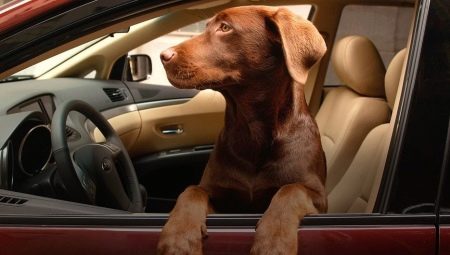
The presence of a pet imposes certain obligations on its owner that require careful implementation. And the transportation of an animal in a car must also take place according to certain regulations. Only after making sure that the dog will be safe during the trip or travel, you can put the four-legged passenger in the cabin.
What rules should owners obey? How to choose an auto hammock and cages, covers and carriers with which you can transport dogs in the car? In search of answers to these questions, it is worth refreshing your knowledge of traffic rules and taking into account the peculiarities of the pet's behavior in the car.
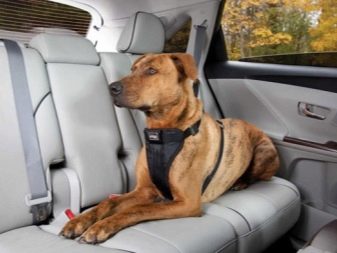
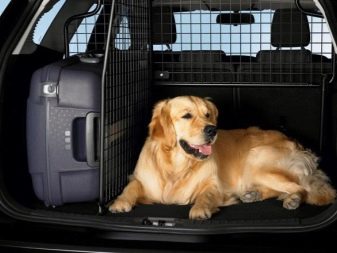
Transportation rules
If you are going on a long journey, the animal should be arranged as comfortably as possible. The dog's vestibular apparatus is also not very suitable for traveling in a car - the dog can get seasick. Besides, it is worth taking personal protective measures for the pet - fasten it on a leash or place it in an aviary, cage, carrier, limiting mobility. This is necessary so that the dog is not in danger in the event of a collision or emergency braking.
Technically, the process of transporting dogs in cars and trucks is equivalent to the transit of household goods. Special permits are not required here, and you do not need to carry documents with you either. They will only be needed on long journeys, when crossing the border. A special procedure has been established only for hunting dogs - they are transported with a special passport and veterinary documents confirming the availability of vaccinations.

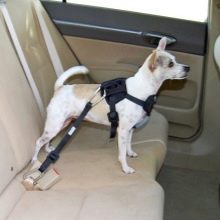
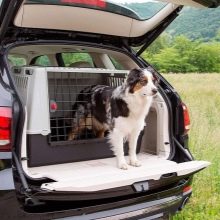
This requirement applies only to the territories related to wildlife sanctuaries and hunting farms.
According to the requirements of the traffic police, when transporting a dog in a car, its owner must comply with the following rules.
- The placement of the animal must exclude interference with the driver while driving. Its location on the hands of a person driving, free movement in the area of pedals and other controls is excluded.
- The dog must not be allowed to obstruct the view. Even a small dog can become a big hindrance in an emergency.
- Securely fix the animal during transportation. For the safety of the dog, maintaining optimal sanitary conditions in the cabin, this rule should be strictly observed.
- In case of interregional transportation of an animal, no later than 5 days before the date of travel, you must obtain a certificate from the veterinarian in the form F1, confirming the absence of quarantine for dangerous infectious diseases from the place of departure.

EU requirements
Traveling abroad with a pet also needs to be done according to the rules. For the EU countries, they will be as follows.
- Chipping mandatory for travel to almost all EU countries. A note about him must be present in the veterinary passport.
- Vaccination against rabies - not earlier than a month and not later than a year from the date of the last vaccination. Additionally, after 30 days, a blood test is performed to confirm the formation of antibodies. It must take place 3 months before leaving the country.
- When exporting rare breed dogs, the owner of the dog must have permission from RKF.
It is forbidden to transport animals of fighting breeds, newborn puppies, pregnant bitches to the borders of the EU countries.
In the case of taking the dog out for treatment, it is worth consulting with the veterinarian in advance about the documentation requirements.


Informal safety measures and rules
In addition to the official regulations, there is also an unspoken order that responsible animal owners try to adhere to. Safety measures to ensure the dog's comfort during transport.
- Restrictions on opening windows in the heat... If the car is not equipped with air conditioning, the door can only be slightly opened so that the animal's head does not pass into it. Otherwise, the pet may catch a cold, get injured from falling stones or debris, earn otitis media, conjunctivitis.
- Maintaining the optimum temperature in the cabin. The body of a dog, already not too adapted for autotravel, in hot conditions can show a negative reaction. Heart palpitations, increased blood pressure, dehydration, shortness of breath and fainting - these are just a small part of what threatens an animal trapped in a heat in a confined space. Too low a temperature in the cabin is also dangerous, as it can lead to disturbances in the functioning of the immune system.
- Correct dog placement. The front seats are not well suited for transporting animals and pose the greatest danger. Well-equipped with special accessories, the rear row of seats is the optimal solution. It is imperative to fasten the dog with a seat belt through the adapter or place it in a fixed carrier.
- Full control... It is very important not to leave your dog alone. When leaving the car, even for a short time, it is worth taking it with you.
By observing these rules, you can provide your dog with comfort and safety when traveling short and long distances.

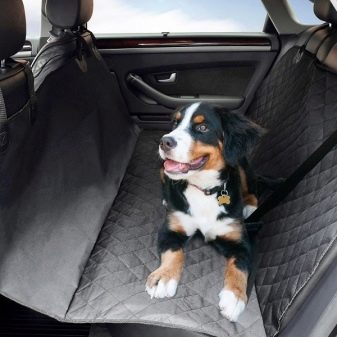
Veterinarian recommendations
Veterinarians also recommend observing certain requirements. So, before any trip, the dog must empty the bladder and intestines, and absorbent napkins and diapers must be available inside the car. It is worth consulting in advance about anti-motion sickness medication and give the medicine prescribed by the veterinarian to the pet in advance. In hot weather, it is better not to muzzle the dog.
In winter, it is recommended to ventilate the cabin from time to time, especially if the dog being transported is large enough.
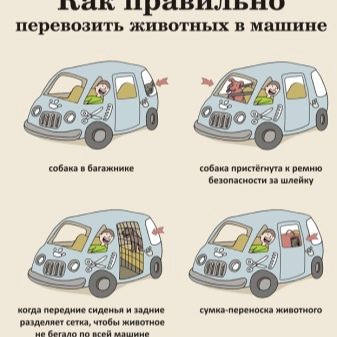
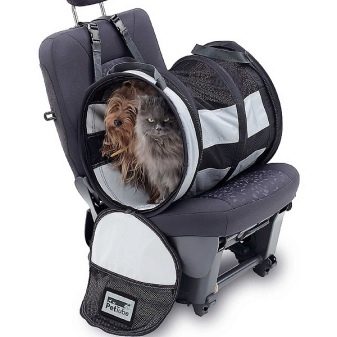
What to transport?
When solving the issue of creating optimal conditions for dogs in a car, one must be guided not only by the traffic police regulations, especially since they do not give exact requirements for fixing the animal. The owner has the right to decide for himself what kind of road transportation will be: giving the animal freedom of movement or limiting it for the safety of the driver and passengers.
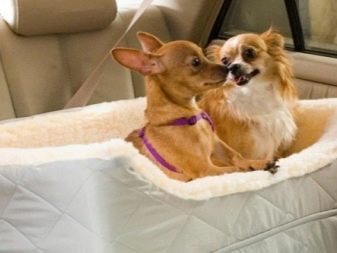

Cell
The simplest solution is a solid, reliable cage that fits the size of the animal. It is quite easy to fasten it in the passenger compartment with seat belts and place it behind the seats. But there is one important point: no matter how much you want to give your pet space, you will have to remember about safety measures. In a large or oversized cage, in case of danger, the dog will beat against the walls, and may be injured. When choosing a cell it is worthwhile to provide a place for a feeder with high sides, a sippy cup. Miniature animals can be offered a tray or simply covered the bottom with a diaper. A large dog should be provided with a bedding, measures should be taken to fix the entire structure with belts or other types of fasteners.
The use of a cage greatly facilitates the driver's work: he does not need to fear that the dog's actions on the road will lead to risky situations. Even animals that do not differ in exemplary behavior are protected from injury when transported in this format. In addition, if the dog is transported for the first time or is generally not too trained, it is worth choosing this particular option of isolated boxing simply in order to prevent escape and loss of the pet.
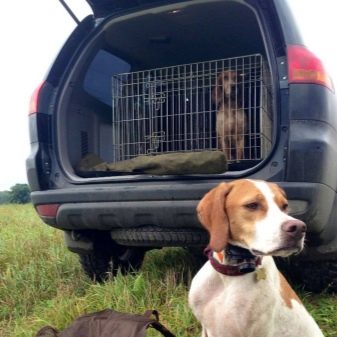
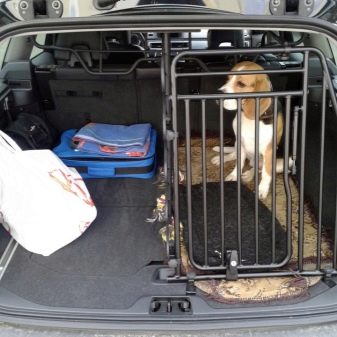
Carrying
If the cage is open on all sides, the net is only in the front of the carrier. This makes the animal feel more secure. This format is convenient for owners of small dogs who do not want to part with their pets on trips and travels. This can be a soft cloth bag or a tough and fairly sturdy container. Anyway it is imperative to provide for the presence of good ventilation inside, take care of fixing the carrier in the car.
The compact box is not suitable for transporting a dog in hot weather, especially over long distances. Tightness, contact with direct sunlight increases the likelihood of overheating. But with a carrier, you can get to the veterinarian or dog hairdresser, go to the dacha or a picnic, without risking that the pet will run away or make a commotion in the car.
During transportation, it is better to fix the box with straps in the back seat.
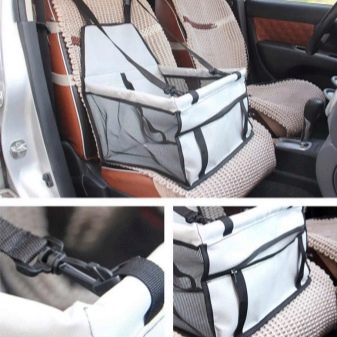

Partition
If cages and carriers seem to be a serious restriction for a freedom-loving pet, you can use a partition to isolate it from the passenger compartment with the driver and other passengers. It can be used to separate the rear seat, preventing the dog from getting into the front row of seats. The partition itself may well be lattice, not restricting the view of the animal. When transporting two large dogs, it is worth choosing a vertical insert to protect the animals from injury. It is matched to the size of the luggage compartment (in station wagons) or taking into account the parameters of the passenger compartment.
If you do not want to install a stationary grid, you can use a removable type nylon mesh. It is fixed on the ceiling and on the sides of the cabin, providing opportunities for isolating the pet without severely restricting its freedom. In this case, it is better to protect the seats from above with a mat.
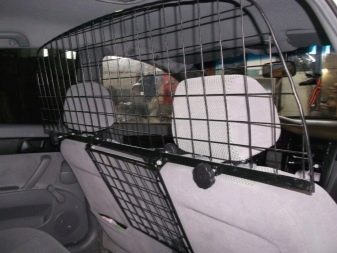
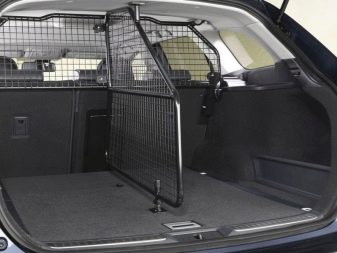
Trunk cover, hammock or seat cover
A banal blanket or blanket is not the best option when it comes to transporting a dog. For those who often travel with the dog in the car, you need more than just bedding. There are special requirements for the material:
- its structure should be moisture resistant, easy to clean;
- it is better to choose a lint-free surface;
- resistance to wear, contact with teeth and claws is a priority;
- reliable fasteners are required.
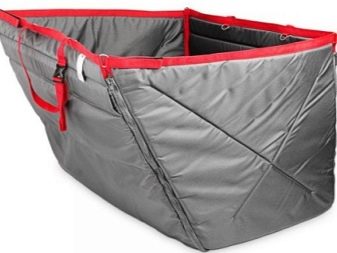

Classic capes with fasteners are a good solution if the dog is traveling in the luggage compartment. In combination with the lattice partition, a comfortable and safe space for a large dog can be obtained. For the salon, capes are produced that occupy the entire back seat and descend to the floor - here you can place a tray.
Protection on three sides will help the dog feel safe and protect the driver from the intrusive attention of a four-legged friend. Door panels can also be protected with boosters - removable pads will soften a possible shock and protect the handles from the teeth of an active puppy.
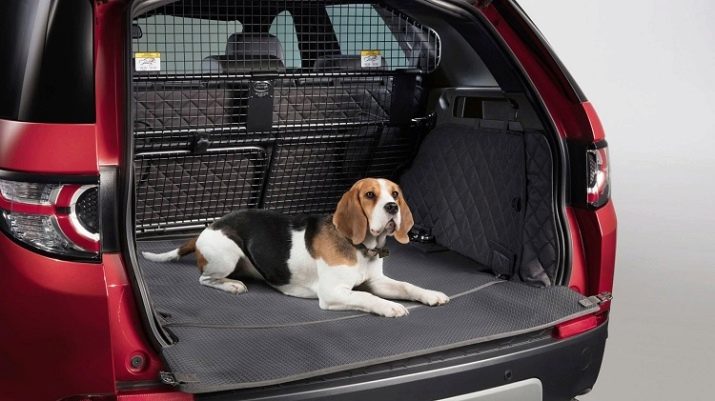
Another option is a full-fledged hammock that prevents the animal from getting into the front seats. Its shock-absorbing properties are quite enough to protect the dog from hitting the seat back during hard braking. For dogs who love to chew on the surrounding objects, you can buy an auto hammock in the car, closed on 4 sides. High sides create a kind of arena that protects the pet from any troubles. A large dog is removed from such a device using detachable walls.
If we compare covers, capes and hammocks with each other, the third option will clearly win both in terms of animal safety and the level of protection of the cabin. In addition, the size of the fixture can be absolutely anything - from compact to occupying the entire back seat. And if you want to go on a long trip with a medium-sized fidget pet, you can purchase a tunnel.
Such a "den" is located on the back seat, securely fixed with belts, when folded takes up a minimum of space, allows you to install drinkers, feeders and a tray inside.
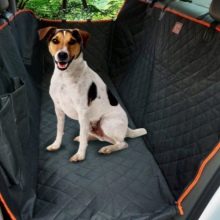
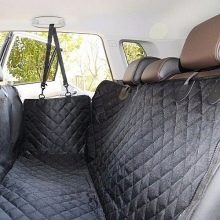
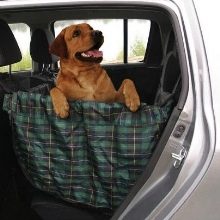
Car harnesses
Even a pet that behaves impeccably in a car needs protection from possible road hazards. Of course, it is impossible to fasten an animal with belts for a person. But there are harnesses with wide belts that easily and safely fix the chest, neck, ribs of the animal. The structure must have seat belt for attaching to the standard socket of the car seat. In this case, the pet will be completely protected from road accidents, and the driver will be able to safely drive the vehicle.
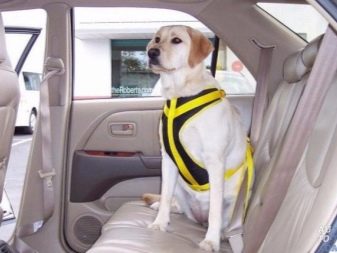
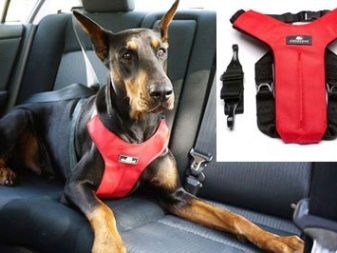
Carrying selection criteria
If we are not talking about long-distance travel, carrying will be the best solution for short-term (no more than 1-2 hours) trips of the dog in the car. In an insulated box, you can create all the conditions for a puppy and an adult animal. It is easy to maintain a high hygienic level, can be washed, supplemented with a safe drinker or favorite toy. Absorbent diapers laid inside the box will save you from excess fluid in the cabin.
Everything that cannot be securely fixed and well ventilated is definitely not suitable for car trips.... These are backpacks where the dog has a limitation in movement and can easily get heatstroke, as well as light and soft bags. Any devices requiring contact with the owner are also excluded. It is better to leave slings and other devices at home: the dog should not interfere with the driver.
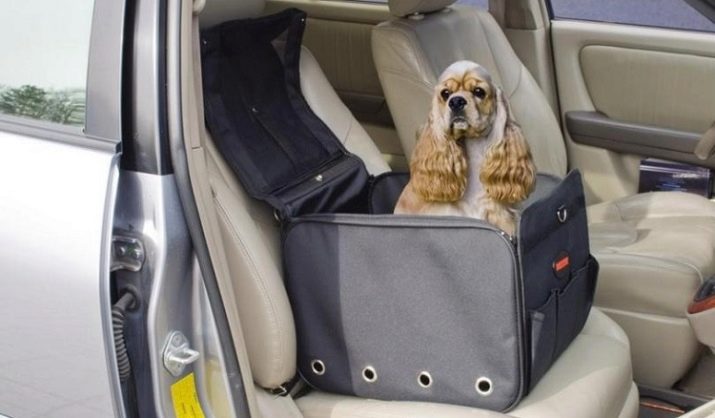
A soft carrier for a dog isn't a good idea either. It is suitable only if the animal has an accompanying person holding the "house" in his arms or next to him on the seat. The optimal solution for frequent trips will be only a rigid container with a lattice front wall: a box, a cage or a "suitcase" on wheels. When choosing it, you should pay attention to the following points.
- The size. The dog should calmly stand in the box, turn around in it. The width of the box should correspond to the length of the animal's body from the tip of the nose to the tail.
- Material. Better to give preference to high-quality hypoallergenic plastic with a sufficient number of holes for ventilation.If a small puppy is being transported, the priority will be the safety and washable properties of the materials. Keeping the crumbs clean is much more difficult.
- Bottom. It should be tough, flat and stable. You can purchase a special non-slip mat inside, easy to clean and washable.
- Availability of special belts and fasteners for the car will be a big plus. If not, you should purchase these accessories separately.
- Carrying - subject of individual use. It is not necessary to transport different animals or several dogs in one box.
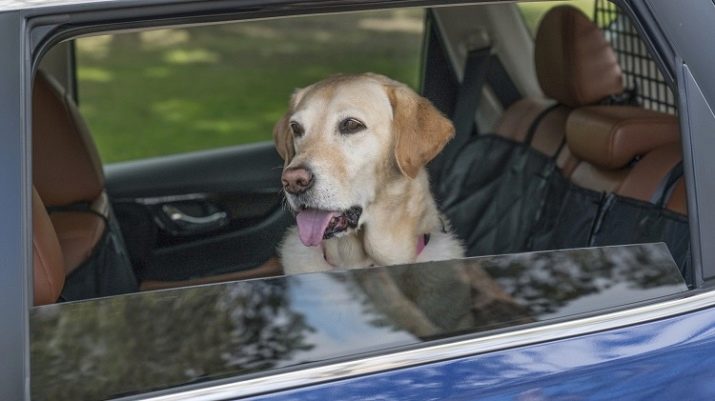

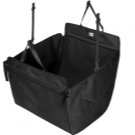
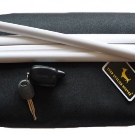

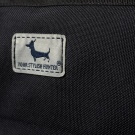
A correctly chosen carrier is a guarantee of the dog's comfort and safety during the trip. You should not risk the life and health of your pet.
It would be much better to take care of his safety in the car, taking into account all the established rules, and to make joint trips pleasant for all "crew members".
For information on how to transport a dog in a car, see the next video.






































